
Food Safety Bulletin for Consumers 2012 (1 st Issue)
Published by the Centre for Food Safety
Feature Articles
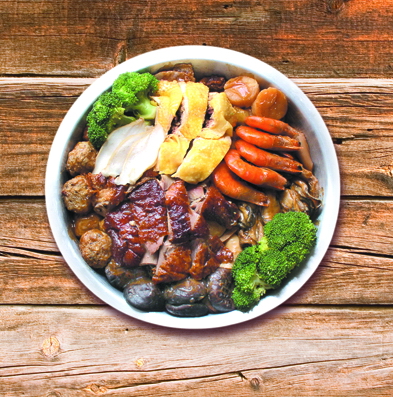
"Poon Choi"
"Poon Choi" is becoming more and more popular. The public should pay attention to food safety when buying or preparing the dish.
"Poon Choi", a kind of traditional food among the indigenous residents of the walled villages in the New Territories, has a history of hundreds of years. Nowadays, "Poon Choi" feasts are still held in many walled villages on festive occasions. Many restaurants offer "Poon Choi" to entice customers, who can place an order and take the food home.
"Poon Choi" is a mixed dish with a lot of ingredients, and it involves a complicated preparation process. The cooked "Poon Choi" is usually kept for some time before served. Therefore, the public should pay attention to food safety when buying or preparing the dish.
Points To Consider When Purchasing "Poon Choi"
- Ordering "Poon Choi"
- Order "Poon Choi" from reliable licensed suppliers.
- Ask the suppliers how the "Poon Choi" should be reheated.
- Specify the time of delivery / collection.
- Pick up "Poon Choi" on time to prevent microbiological growth due to prolonged exposure to the temperature danger zone of 4 ℃ to 60 ℃ .
- Transporting and Receiving "Poon Choi"
- Cover "Poon Choi" properly.
- Use insulating equipment during transportation.
- Reheat "Poon Choi" upon its arrival if it is to be consumed immediately. "Poon Choi" should be allowed to cool down as soon as possible and covered properly if it is not for immediate consumption. It should be kept at 4 ℃ or below in the chiller within 2 hours and be separated from raw food to prevent cross-contamination. Alternatively, its temperature should be maintained at above 60 ℃ until consumption.
"Poon Choi" should be kept at above 60 ℃ during transportation.
Preparing "Poon Choi" at Home
- Plan Carefully in Advance
- Make proper arrangements to ensure that adequate facilities such as stoves and refrigerators are available. Estimate carefully the amount of food required. The ingredients should be purchased from reliable shops.
- Estimate the time required for preparation so that foods, especially those that are perishable or easily contaminated, are not cooked too far in advance.
- There should be enough space in refrigerators for storing raw and cooked foods separately. Cover raw and cooked foods properly and keep them on different shelves in the refrigerator. Cooked foods should be placed on upper shelves and raw ones on lower shelves to prevent cross-contamination.
- Keep chillers at 4 ℃ or below and freezers at -18 ℃ or below.
- Use separate utensils to handle raw food, cooked food or ready-to-eat food.
- All utensils should be cleaned thoroughly.
- Defrost frozen foods in chillers ( 4 ℃ or below ) or under cool running water.
- Cook foods (especially high risk foods like seafood and poached chickens) thoroughly.
- Maintain Good Personal Hygiene Practices
- Wash hands with liquid soap for at least 20 seconds before handling foods or after using toilets.
- Persons with contagious diseases like gastroenteritis or influenza should not handle foods.
Cooked "Poon Choi" should be put into serving containers as soon as possible to prevent food contamination.
Consumption of "Poon Choi"
- Reheat and consume "Poon Choi" as soon as possible after receiving it.
- Keep "Poon Choi" at above 60 ℃ or at 4 ℃ or below if it is not consumed immediately.
- Avoid storing of "Poon Choi" at ambient temperature for more than 4 hours.
- Do not consume "Poon Choi" which has been kept at ambient temperature for more than 4 hours.
- Reheat "Poon Choi" thoroughly to the complete boil before consumption.
- Finish it in one go and do not keep leftovers.
- Use communal chopsticks and spoons.
- If there are abnormalities , stop consumption immediately and contact the supplier or the Food and Environmental Hygiene Department (FEHD).
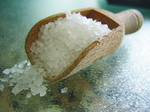
Readers' Corner
Stroke Prevention with a Low-sodium Diet
On the way to the supermarket, Dr Lau, Mrs Lau and their son Sam ran into Uncle Lee.
| Mrs Lau : | Oh Dear, we haven't seen Uncle Lee only for some time, why has he changed so much? His speech becomes slurred, and he has to walk with a cane. |
| Dr Lau : | Yes, Uncle Lee was attacked by stoke recently. Fortunately, his family discovered he had a stroke and rushed him to the hospital without delay. He was then given timely diagnosis and proper treatment. But in the days ahead, he has to keep his illness under control, including changing his lifestyle, in order to reduce the risk of another stroke. |
| Mrs Lau : | Sam, do you know what stroke is? |
| Sam : | Sure, our biology teacher told us before. Before the stroke, Uncle Lee could move freely and speak clearly; now the stroke has affected some of his bodily functions. |
| Dr Lau : | Well, the medical term for stroke is cerebrovascular disease. To make it simple, it is caused by "blockage" or "rupture" of some blood vessels in the brain, leading to sudden obstruction of blood supply to it. The brain cells will die because of no supply of nutrients and oxygen, and the affected area of the brain will lose its ability to function. The resulting damage mainly depends on the location and extensiveness of the stroke. People suffered from a stroke may lose their mobility forever. For example, they may be paralysed, or even die in the attack. |
| Sam : | Dad, what is "blockage" or "rupture" of brain blood vessels? |
| Dr Lau : | "Blockage" of brain blood vessels means the blood vessels in the brain are obstructed, resulting in ischaemic stroke. "Rupture" of a brain artery means an artery in the brain bursts, resulting in haemorrhagic stroke. One of the most common causes of bleeding in the brain is high blood pressure, which can cause the small vessels to explode. |
| Sam : | Is high blood pressure the same as hypertension? Our teacher said that maintaining a balanced diet, regular exercise and an ideal body weight would reduce risk of developing eating-related diseases such as hypertension. Our teacher also said salt was placed at the "Eat the Least" level at the top of the Food Pyramid, and it should be taken in small amount. Dad, why do people have increased blood pressure as a result of eating too much salt? |
| Mrs Lau : | Common salt is mainly composed of sodium chloride, which exists as sodium ions and chloride ions in the human body. Sodium makes up 40% of common salt. In other words, there are 400 mg of sodium in each gram of salt. Sodium is a kind of mineral that helps to regulate water and pH balance in our body. Therefore, an adequate intake of common salt is vital for maintaining our life processes. Inadequate or a lack of sodium will lead to fatigue and weakness. |
| Dr Lau : | Under normal circumstances, the human body needs only 200 to 1 000 mg of sodium each day and any excess amount will be excreted in urine. Sodium is present in natural foods like milk, fish, meat, vegetables and fruits. As the level of sodium in these foods is enough to fulfill our daily sodium requirements, there is no need to obtain sodium from extra sources like salt or sodium-containing condiments. Prolonged excessive intake of sodium will upset the regulation of blood volume and impair the elasticity of blood vessels, thus elevating the blood pressure. |
| Sam : | Does it mean that we will not suffer from stroke if we do not take in salt at all? |
| Mrs Lau : | Common salt is not the only dietary source of sodium. Sodium is also found in natural foods, processed foods and condiments. Common Chinese-style condiments such as soy sauce, oyster sauce, chicken powder and fermented red bean curd, and assorted sauces and condiments used in western cuisine such as black pepper sauce, mustard and grated cheese are rich sources of sodium. Moreover, processed foods like ham, luncheon meat, bacon, sausages and Chinese sausages are also high in sodium. |
| Dr Lau : | As recommended by the World Health Organisation, a healthy adult should take in no more than 2 000 mg of sodium per day, which is equivalent to the amount present in a level teaspoon of common salt. The salt intake for children should be lower than that of adults. The younger one is, the less sodium one needs. |
| Mrs Lau : | So, who is more susceptible to hypertension and stroke? |
| Dr Lau : | There are many causes for hypertension and stroke. The risk of developing these two conditions increases with age. Those who are physically inactive, overweight or have an unhealthy diet are more prone to hypertension and stroke. |
| Mrs Lau : | Sam, I keep telling you not to have too many high sodium snacks, like sauce-mixing type instant noodles, potato chips, fish balls and siu mai. Do you know why? |
| Sam : | Yes. You mentioned that the dietary habit developed in childhood will often be carried on to adulthood. For instance, kids who are used to having heavily flavoured dishes will usually have a similar taste in food when they grow up. |
| Mrs Lau : | That's right. A high salt diet will lower the sensitivity to taste. As a result, one tends to go for more savoury and heavier tastes. On the contrary, if one keeps a low salt / sodium diet with light-flavoured foods, the risk of stroke in adulthood may be reduced. |
| Sam : | Dad, there is a Cantonese slang that goes "I've eaten more salt than you have of rice". Doesn't Grandma say so all the time? I bet her taste buds are really insensitive! |
| Dr Lau : | That's funny. Back then, we did not have a refrigerator. Shopping was not as easy and convenient as it is today, and that was why we would buy a large amount of food in each shopping trip. As unpreserved foods like fish and vegetables would go bad easily, Grandma tended to stock up on preserved products like salted fish, preserved mustard greens and canned food, which are all sodium-dense. That was how Grandma developed a taste for heavily flavoured food. Nowadays, however, food manufacturers have come up with various means of food preservation without using salt or sodium, like freezing and using legal and harmless substitutes of sodium. |
| Mrs Lau : | Our sense of taste is highly adaptable. Having switched to unsalted foods, our taste buds will get used to their natural tastes after a while. Under our influence, Grandma now prefers only fresh and light-flavoured foods. She does eat preserved foods once in a while, but only in small amounts. |
| Sam : | What kinds of snack are high in sodium and what kinds are low in sodium? |
| Mrs Lau : | Snacks high in sodium include biscuits, crisps, baked salted nuts/peanuts, dried meat, dried fish, preserved fruits, preserved prunes and snack type seaweeds; whereas, unsalted or low salt biscuits, nuts, fresh fruit, vegetables (juice) and milk products are healthy snacks low in sodium. |
| Sam : | I know, nutrition labels on food packages also contain information on sodium. Are there any ways to reduce the intake of sodium other than refraining from eating snacks? |
| Dr Lau : |
There are plenty of ways. When eating at home:
|
| Mrs Lau : |
When eating out:
|
| Sam : | My classmates like to eat savoury snacks. Some of them even prefer rice soaked in gravy. I have to tell them that taking in too much sodium in our diet will increase the risk of hypertension and stroke in the long run. |
| Mrs Lau : |
Good boy! Ah, here it is. Tonight, I'll cook your favourite "low-sodium lo-shui chicken drumsticks" with this bottle of reduced -sodium black soy sauce and Chinese prickly ash and star anise. |
| "Hurrah for Mom!" Dr Lau and Sam said in unison. | |
News on New Dishes
Innovative Cantonese Cuisine – Steamed Bamboo Pith Rolls with Black Fungi and Bean Curd
"All delicious food is in Canton ", as the saying goes. Cantonese cuisine stresses five aspects of flavour and six aspects of taste. For the five aspects of flavour, the dishes should be aromatic, tender or smooth, oily but not too greasy and rich but not too strong. Regarding the six aspects of taste, attention is paid to sourness, sweetness, bitterness, hotness, saltiness and freshness of the food. As a Cantonese restaurant famous for its contemporary "original flavour" dishes, Jasmine Garden not only preserves the above-mentioned aspects of Cantonese cuisine, but also introduces the elements of health and food safety into cooking to tie in with the modern trend of dining. In this issue of News on New Dishes, we have invited Chef Mark KO Wai-yuen from Jasmine Garden to demonstrate how to prepare a dish filled with poetic beauty – Steamed Bamboo Pith Rolls with Black Fungi and Bean Curd.
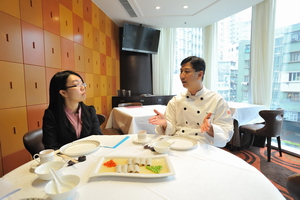
Steamed Bamboo Pith Rolls with Black Fungi and Bean Curd
| Preparation Steps | Getting to know more | |
|---|---|---|
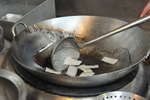 Soaking Soaking |
Soak the bamboo pith and dried black moss in water separately for 2 to 3 hours. | Soaking softens the bamboo pith and dried black moss. This step not only prepares them for further handling, but also removes contaminants such as sand and mud effectively. |
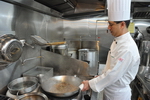 Blanching Blanching |
Blanch the bamboo pith, shredded fillings (dried bean curd, carrots, black fungi and vegetarian chicken) and garnishes (Chinese wolfberries and young soya beans) in hot water separately for a short while. Drain them dry. | Ingredients blanched for a short while can absorb flavours better. Blanching can also remove possible pesticide residues. |
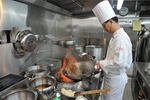 Stir-frying Stir-frying |
Stir-fry the fillings in wok briskly and season with chicken soup. Add corn flour water to thicken the sauce. | Brisk stir-frying retains the nutrients of food. It also cooks food thoroughly without sacrificing the colour, aroma and flavour of the food. |
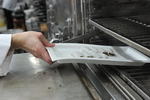 Steaming Steaming |
When the fillings have cooled down a little, pipe it into the bamboo pith rolls with a piping bag. Put the dish in the steam cabinet to steam for 5 minutes. | The fillings can either be piped into the bamboo pith rolls right away or be left to cool down for later use at a temperature of 4 ℃ or below. However, to ensure food safety, it should not be stored at room temperature for more than 4 hours. |
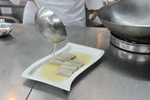 Saucing Saucing |
Prepare the sauce with chicken soup, salt, sugar, pepper powder and corn flour water. Pour the thickened sauce onto the bamboo pith rolls. Garnish the dish with Chinese wolfberries and young soya beans. | Ensure that the chicken soup has been kept boiling for at least 1 minute before pouring it onto the steamed bamboo pith rolls. |
Tips from KO:
Chef KO from Jasmine Garden told us about their measures for safeguarding food safety.
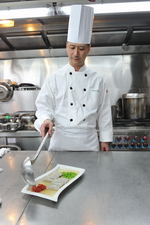
Chef KO demonstrates how to prepare "Steamed Bamboo Pith Rolls with Black Fungi and Bean Curd"
- Buy ingredients from reliable suppliers to ensure guaranteed qualities and hygiene standards of the food purchased.
- Upon receipt of the ingredients, colleagues from the quality control section will check carefully to ensure that the products are up to standard. When the ingredients are delivered to the branches of the restaurant, colleagues from the kitchen section will conduct quality checks again. If unsatisfactory items are found, they will report to the quality control section immediately. To safeguard food safety and maintain reputation of the restaurant, the colleagues concerned will closely monitor the performance of the suppliers.
- Jasmine Garden attaches great importance to environmental hygiene of the kitchen. From cooking utensils to worktops, the floor and the wall, everything has to be clean and hygienic.
- The staff will put on clean gloves before touching cooked ingredients. When Chef KO demonstrated how to prepare the dish, he practised what he said by putting on disposable gloves before stuffing the bamboo pith rolls to prevent direct contact between his hands and the food.
- Chef KO also inspects various branches of the restaurant regularly to ensure that quality of the food is of the same standard and performance of the staff meets the requirements with a view to producing fine cuisine which is high in standard and safe to consume.
Jasmine Garden has become a signatory of the Food Safety Charter for three consecutive years since 2009. It has fulfilled its mission as a signatory and joined hands with the Government to promote food safety to the public.
Food Safety Plan Corner
Steamed Bamboo Pith Rolls with Black Fungi and Bean Curd
Critical Control Point – Cook Food Thoroughly
 |
 |
||
 |
 |
 |
 |
 |
 |
Ingredients:
Bamboo pith, dried bean curd, carrots, dried black moss, black fungi, vegetarian chicken, Chinese wolfberries and young soya beans
Seasoning:
Salt, sugar, pepper powder, corn flour and chicken soup
Steps:
- Cut bamboo pith into sections. Soak and bring them to a quick boil. Season with chicken soup.
- Rinse and shred dried bean curd, carrots, dried black moss, black fungi and vegetarian chicken . Bring them to a quick boil. Add chicken soup, corn flour and oil as seasoning. Stir-fry until cooked and leave to cool.
- Stuff the bamboo pith rolls with the shredded dried bean curd, carrots, dried black moss, black fungi and vegetarian chicken. Steam for 5 minutes and dish up. Pour the sauce made from chicken soup, salt, sugar, pepper powder and corn flour onto the bamboo pith rolls.
- Rinse the Chinese wolfberries and young soya beans. Bring them to a quick boil and season with chicken soup. Place them beside the bamboo pith rolls for garnishing.
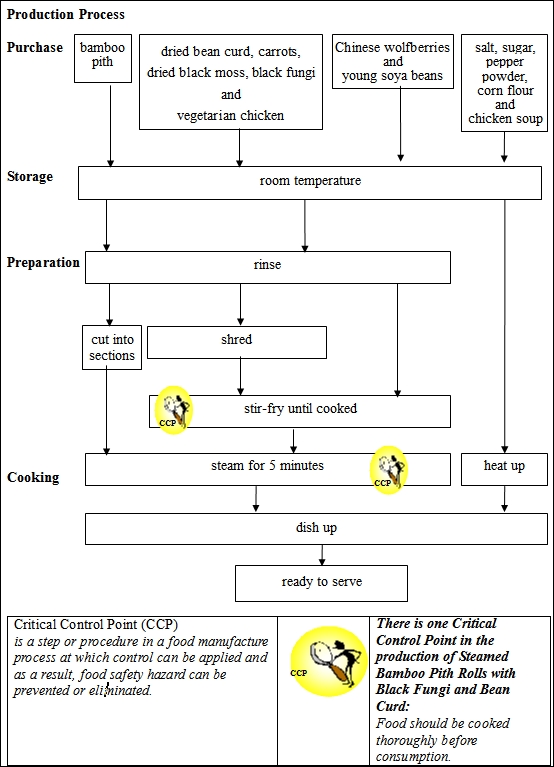
Food Safety Q&A
| Question: |
Will all prepackaged food bear nutrition labels? |
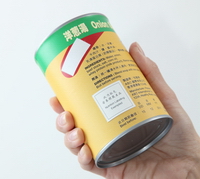 |
| Answer: |
No. According to the Food and Drugs (Composition and Labelling) Regulations, a small number of items of food are not required to bear nutrition labels, e.g.:
Under the current legislation, formula and food intended to be consumed by children under the age of 36 months and food for special dietary uses* are not mandatorily required to bear a nutrition label. However, nutrition labels can be affixed to these kinds of products on voluntary basis. Members of the trade are also encouraged to provide detailed nutrition information on the food labels of these products for reference of consumers. * Food for special dietary uses is those specially processed or formulated to satisfy particular dietary requirements which exist because of a particular physical or physiological condition and/or specific disease and disorders and which are presented as such. For example, dried milk specially formulated for pregnant women, food products specially formulated for cancer patients, etc. The general public do not need to consume these products. Consumers are advised to consult healthcare professionals if they have doubt about these products. |
|
Briefing of Activities
The 46 th Hong Kong Brands and Products Expo
The 46 th Hong Kong Brands and Products Expo organised by The Chinese Manufacturers' Association of Hong Kong was held from 10 December 2011 to 2 January 2012 at Victoria Park, Hong Kong. As in the past, the Centre for Food Safety (CFS) was invited to promote safety in food at the Expo.
The CFS's exhibition booth provided mainly materials introducing food safety, the related measures and promotional activities, as well as nutrition labelling and the Food Safety Ordinance. Staff of the CFS briefed visitors and distributed leaflets and pamphlets to them.
A quiz was also designed for participation of visitors with the main objective of promoting the Nutrition Labelling Scheme and the dietary habit of "3-low" (i.e. low salt, low sugars and low fat).
Upcoming Activities
Consumer Liaison Group welcomes you!
| The Consumer Liaison Group (CLG) provides a platform for the Centre for Food Safety (CFS) to communicate with the public. Through organising activities and focus group meetings for consumers, the CFS can have a better grasp of their knowledge, beliefs and risk perception on various food safety issues for developing effective risk communication strategies. | 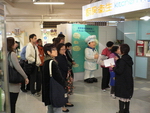 CLG members visit the exhibition hall of the Health Education Exhibition and Resource Centre. |
| The CLG arranged two visits late last year and early this year. CLG members were invited to visit the Health Education Exhibition and Resource Centre of the Food and Environmental Hygiene Department (FEHD) and beverage manufacturer Swire Coca-cola HK Ltd. Participants were satisfied with the arrangement of the activities which they said helped them understand the work of the FEHD and the manufacturing process of the food trade in Hong Kong. |  CLG members visit the Coca-Cola Museum. |
| In addition to taking part in the CFS's activities, CLG members were invited to attend CFS's focus group meetings and participate in surveys to give advice and suggestions on food safety and risk communication issues. |  CLG members express their opinions enthusiastically at a focus group meeting. |
Topics discussed by focus group meetings include:
- Publicity, education and use of nutrition labelling ;
- Publicity and communication activities of the CFS, such as Food Safety Charter, food alerts and audiovisual resources on food safety;
- Food and risks, such as microbiological quality of cut fruits, mercury in fish, foreign substances in food, and trans fat and acrylamide in food;
- Regulatory framework , such as the regulatory framework for pesticide residues in food; and
- Food incident and information dissemination, etc.
The CFS is recruiting members of the 4 th term Consumer Liaison Group. The term of service of the 4 th CLG members is from 1 August 2012 to 31 July 2015 . Those who are aged 15 or above and concerned about food safety issues or the work of the CFS are welcome to join. Members will be presented with a Certificate of Membership. Members who participate in the CFS's activities and provide recommendations will receive a souvenir.
Those who are interested to join may complete the application reply slip and return it to the CFS on or before 31 July 2012 by fax or mail. The application form may be downloaded from the CFS's webpage at http://www.cfs.gov.hk/english/committee/committee_clg.html. Places are limited. For enquiries, please call the CFS on 2867 5149.
Reply slip for Application for
Membership of the 4th term Consumer Liaison Group
Please make copies if necessary
| To: | Centre for Food Safety (Consumer Liaison Group), Food and Environmental Hygiene Department, 43/F, Queensway Government Offices, 66 Queensway, HK |
| Fax : | 2893 3547 |
| Name: (English) (Chinese) Mr/Miss/Ms* | |
| Email: Address: . | |
| Phone: Fax: . | |
|
Statement of Purpose under the Personal Data (Privacy) Ordinance: The personal data provided by means of this form is voluntary and will be used by the Centre for Food Safety for communication, correspondence, statistical and evaluation purpose. For enquiries (including the request for access and correction), please contact Consumer Liaison Group on 2867 5149 (Tel.) or 2893 3547 (Fax.).
|
|
Truth against Fallacy
Is it true that the longer the shelf-life of a pre-packaged food, the more the preservatives are added?
A pre-packaged food with a longer shelf-life does not necessarily mean that it contains more preservatives. In fact, the amount of preservatives added is only one of the many factors affecting the shelf-life of food.
Food of low water content or a relatively high or low pH value can itself inhibit the growth of most spoilage micro-organisms. Such food generally has a longer shelf-life than other food, even without adding preservatives. While heat treatment is a method which can effectively reduce the amount of spoilage micro-organisms in food, vacuum packaging is another way to allow food to last longer on the shelf. Moreover, freezing or chilling can also abate the breeding of spoilage micro-organisms, thus extending the shelf-life of food.
To sum up, provided we understand the properties of the food, use appropriate processing and packaging methods and store food in suitable temperatures, the right amount of preservatives will suffice to extend the shelf-life of food. Adding excessive preservatives may not significantly extend the shelf-life of food, but risks contravening the Preservatives in Food Regulation.
Brain Gym

- products at inexpensive prices
- Food and Drugs (Composition and Labelling) Regulations
- 75 ℃
- Food Safety Ordinance
- over 60 ℃
- reliable
- room temperature
- Preservatives in Food Regulation
- 4 ℃ or below
- We should patronise stores when buying food.
- Hot-served food should be held at to ensure safety of food.
- Storing food at can help extend the shelf-life.
- The use of preservatives in food is regulated by the .
- Food should be reheated so that the core temperature reaches at least before consumption.
| Answers: |
1 – F. reliable |
Enquiry and Subscription
Printed copies of the Food Safety Bulletin can be collected at the Communication Resource Unit located at 8/F, Fa Yuen Street Municipal Services Building, 123A Fa Yuen Street, Mong Kok, Kowloon. For enquiry, please call 2381 6096. The public may also visit the website of the Centre for Food Safety (http://www.cfs.gov.hk) for the online version.
